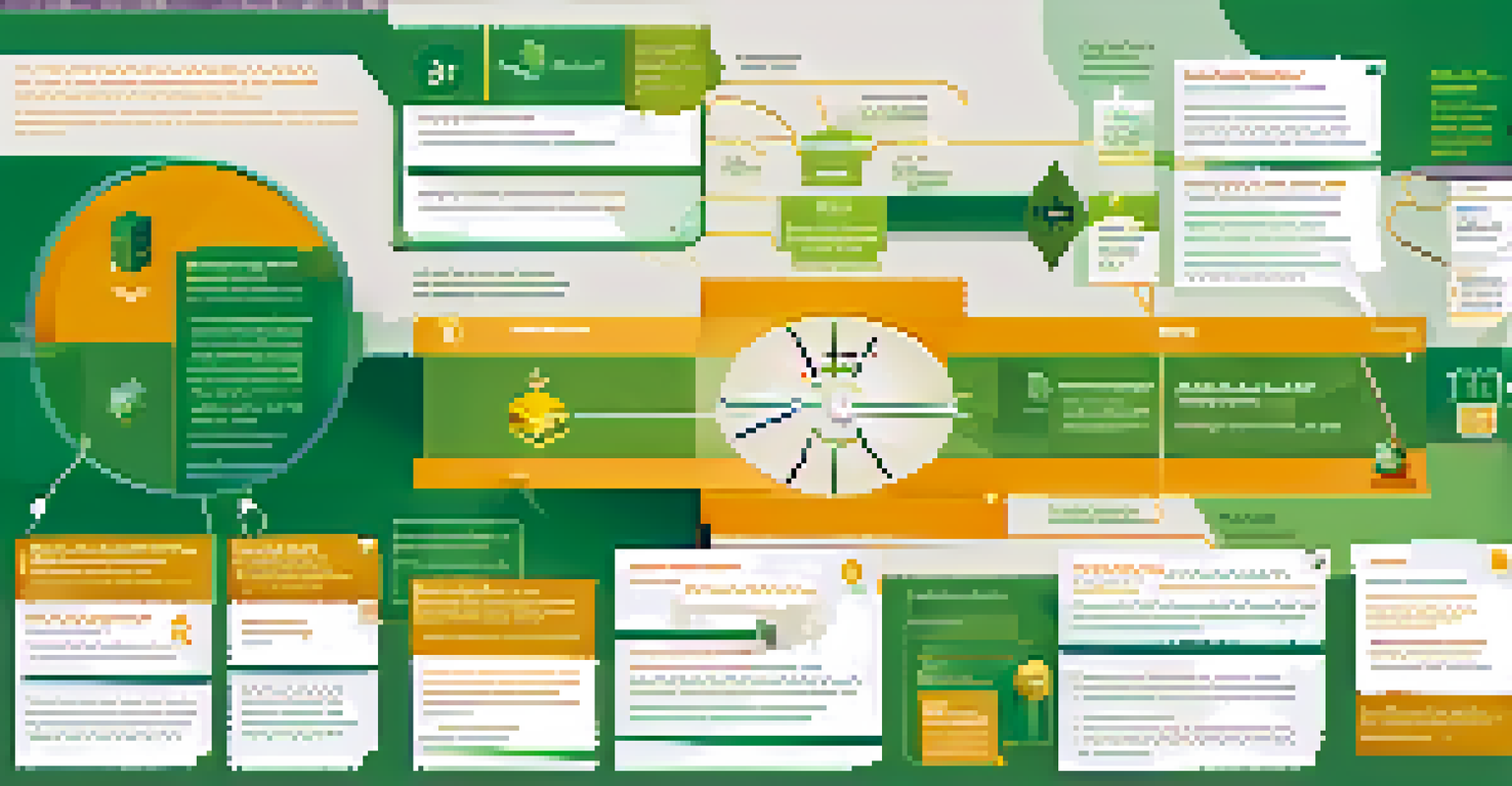Atomic Swaps: Enabling Direct Trades Between Different Blockchains

What Are Atomic Swaps and How Do They Work?
Atomic swaps are a groundbreaking technology that allows users to trade cryptocurrencies directly from different blockchains without the need for a centralized exchange. Imagine trading baseball cards with a friend, where you both simply exchange cards without involving a third party. This technology relies on smart contracts, which are self-executing contracts with the terms of the agreement directly written into code.
Atomic swaps are a significant step toward a more decentralized future, allowing users to trade directly without intermediaries.
When two parties agree to an atomic swap, they create a special smart contract that ensures both sides fulfill their end of the bargain. If one party fails to complete the trade, the contract will automatically return the funds to their original wallets—hence the term 'atomic,' indicating that the swap is indivisible. This process not only enhances security but also boosts trust among users.
Overall, atomic swaps provide a way to bypass intermediaries, reducing fees and increasing trading efficiency. As more people become aware of this technology, it could revolutionize how we think about cryptocurrency trading.
Advantages of Atomic Swaps Over Traditional Exchanges
One of the most significant advantages of atomic swaps is that they eliminate the need for a centralized exchange, which often poses risks like hacks and fraud. By trading directly between wallets, users retain full control over their funds throughout the entire process. Picture it like trading personal items with a neighbor instead of going through a potentially shady pawn shop.

Moreover, atomic swaps can lead to lower fees since users don't have to pay for transaction costs imposed by exchanges. This means more of your money stays with you, which is particularly appealing for frequent traders. Plus, as the crypto space continues to grow, so too do the opportunities for swaps between various cryptocurrencies.
Direct Trading Without Intermediaries
Atomic swaps enable users to trade cryptocurrencies directly between different blockchains, enhancing security and trust.
Another benefit is the increased privacy that atomic swaps offer. With no intermediary involved, users can trade without revealing personal information, making it a more discreet option. This combination of security, cost-effectiveness, and privacy makes atomic swaps an attractive alternative to traditional trading methods.
How Atomic Swaps Enhance Cross-Chain Interoperability
Cross-chain interoperability is the ability of different blockchains to communicate and interact with one another. Atomic swaps play a crucial role in this, acting as a bridge that allows different blockchain networks to exchange value seamlessly. Think of it as a universal remote that can control multiple devices instead of needing separate remotes for each.
The future of money is digital, and atomic swaps are a key component of that transformation.
In a world where blockchain technology is rapidly evolving, fostering interoperability is essential. It opens up new possibilities for decentralized finance (DeFi) applications, allowing users to access a broader range of services and assets across different networks. This means that a user holding Bitcoin could easily swap it for Ethereum without going through an exchange.
As developers continue to improve atomic swap technology, the future of cross-chain interoperability looks bright. With enhanced communication between blockchains, we can expect a more connected crypto ecosystem that benefits everyone involved.
The Role of Hash Time-Locked Contracts (HTLCs)
At the heart of atomic swaps lies a specific type of smart contract known as a Hash Time-Locked Contract (HTLC). HTLCs are designed to ensure that transactions occur only when certain conditions are met, acting as a safety net for both parties involved in the swap. Think of it like a locked box that only opens when the right key is used, ensuring that both users fulfill their part of the deal.
The way an HTLC works is quite ingenious. It requires that one party generates a unique hash and shares it with the other party. Both sides then use this hash to lock their funds in a contract. If the trade is completed, the funds are released; if not, the funds return to their original wallets after a predetermined time. This mechanism adds an extra layer of security and trust to the process.
Lower Fees and Increased Privacy
By eliminating centralized exchanges, atomic swaps reduce transaction costs and provide users with greater privacy during trades.
HTLCs not only facilitate atomic swaps but also enhance the overall reliability of blockchain transactions. By preventing fraud and ensuring that both parties hold up their end of the bargain, HTLCs are essential to the success of atomic swaps and their growing adoption.
Challenges and Limitations of Atomic Swaps
While atomic swaps come with numerous benefits, there are also challenges and limitations that users should be aware of. One major hurdle is the requirement for both blockchains to support the necessary technology for atomic swaps. If two chains don't have compatible protocols, trading between them becomes impossible.
Moreover, the user experience can sometimes be less intuitive than traditional exchanges. For those who aren't tech-savvy, navigating the process of performing an atomic swap can feel daunting. This complexity may deter some users from taking advantage of this innovative technology, especially if they are accustomed to the simplicity of centralized exchanges.
Lastly, scalability can be an issue. As the number of users engaging in atomic swaps increases, there may be concerns about network congestion and transaction times. Addressing these challenges will be crucial for the widespread adoption of atomic swaps in the future.
Real-World Examples of Atomic Swaps in Action
Several projects have successfully implemented atomic swaps, showcasing their potential in the real world. One notable example is the Decred project, which pioneered atomic swaps between its own blockchain and Bitcoin. Their successful implementation demonstrated that users could trade directly between the two cryptocurrencies without needing an intermediary, paving the way for future developments.
Another example is the Lightning Network, which aims to enhance Bitcoin's scalability and speed by enabling atomic swaps. This network allows users to conduct transactions off-chain, drastically reducing fees and transaction times. As more businesses and individuals adopt the Lightning Network, we can expect atomic swaps to become even more prevalent.
Future of Cross-Chain Interoperability
Atomic swaps facilitate seamless communication between blockchains, paving the way for a more connected and user-friendly crypto ecosystem.
These real-world applications not only highlight the feasibility of atomic swaps but also encourage other projects to explore this technology. As awareness grows, we may see an increase in the number of platforms offering atomic swaps, making it a more common method for trading cryptocurrencies.
The Future of Atomic Swaps and Blockchain Trading
As the cryptocurrency landscape continues to evolve, the future of atomic swaps looks promising. With ongoing advancements in blockchain technology and increased interest from users, we can expect to see more innovative solutions that enhance the atomic swap process. Imagine a world where trading assets across multiple blockchains is as easy as sending a text message—this could soon be a reality.
Moreover, as regulatory frameworks surrounding cryptocurrencies become more defined, atomic swaps may gain even greater legitimacy. This could encourage more traders to embrace decentralized options, further shifting the balance away from traditional exchanges. Such a shift would not only empower users but also foster a healthier, more competitive trading environment.

Ultimately, the rise of atomic swaps signifies a move towards a more decentralized and user-centric approach to cryptocurrency trading. As the community continues to explore the potential of atomic swaps, we can look forward to a future filled with seamless, direct trades that redefine how we think about value exchange across blockchains.